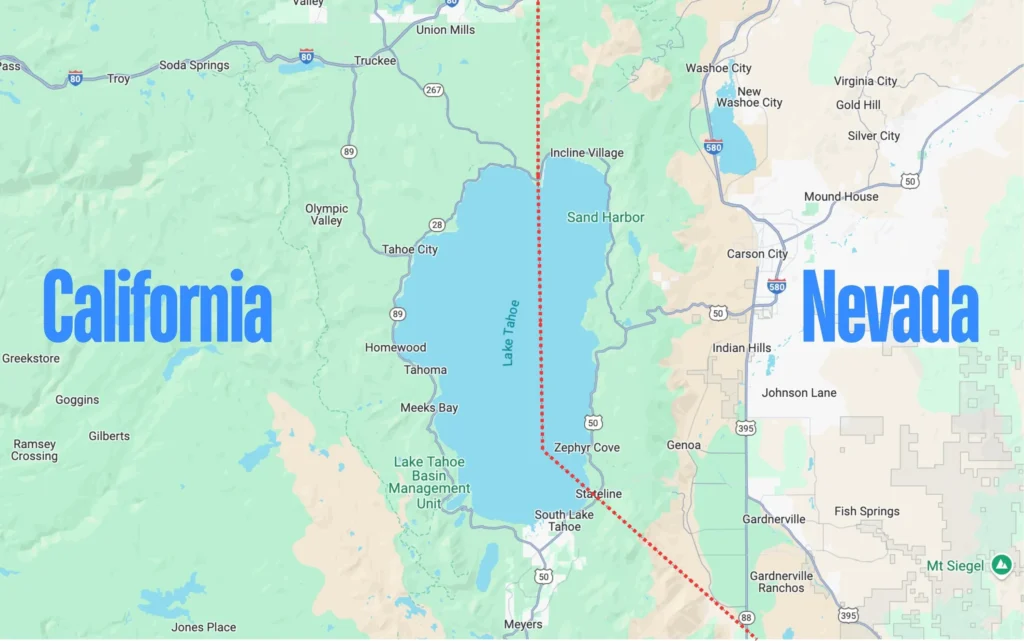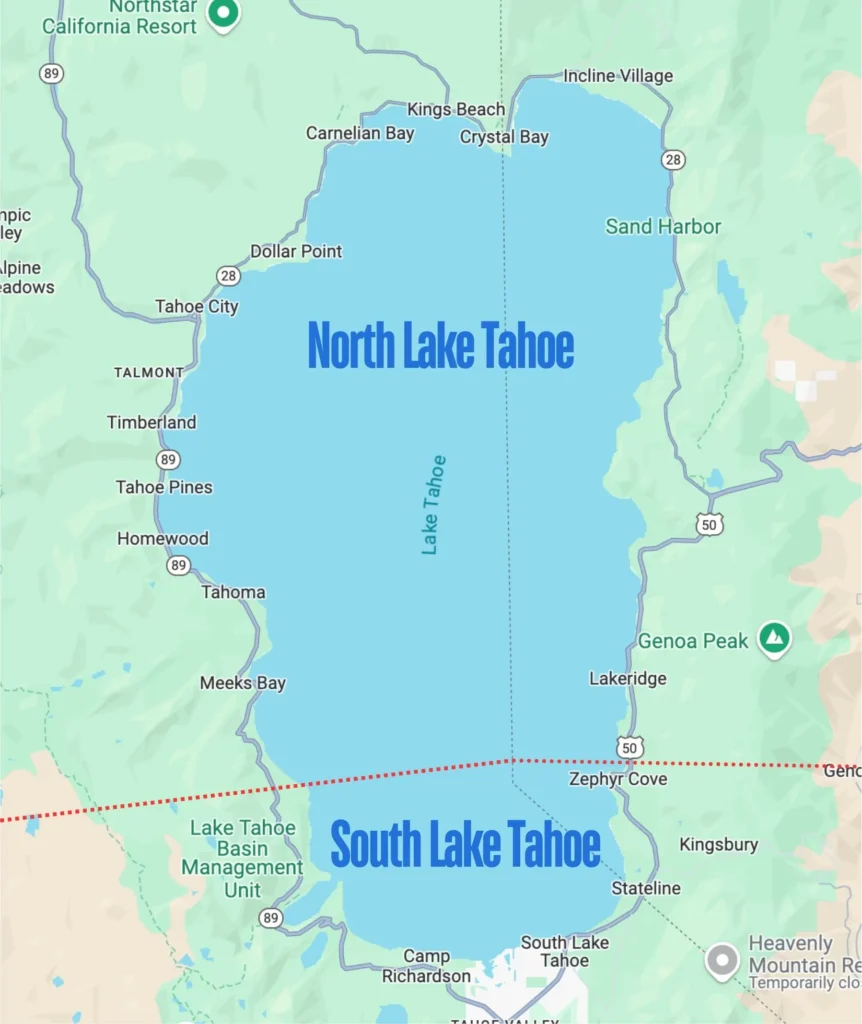Lake Tahoe is one of the most popular destinations in the USA, attracting millions of visitors each year. This high demand makes the vacation rental and second home market thrive, offering substantial revenue potential for investors. However, for the average investor, navigating the complexities of this market can be challenging. Key decisions include choosing the ideal location for a second home—whether to invest in the North Shore or South Shore, and whether the California side or Nevada side is more advantageous. Understanding these factors is crucial for making a successful investment in Lake Tahoe.
In this blog, we will explore which region is perfect for investing in second home in Lake Tahoe, comparing the North Shore versus the South Shore, and the California side versus the Nevada side. We’ll share expert insights from decades of experience to help you make informed decisions for your Lake Tahoe second home investment.
Table of Contents
California vs. Nevada: Which Side of Lake Tahoe is Better for Second Home Investment?
Living in Lake Tahoe whether it is on the California side or Nevada side is wonderful, both of these sides have their own perks, but there are few things that you might wanna consider before deciding to choose a second home.

Tax Benefits
State Income Tax: The Nevada side of Lake Tahoe has no State Income Tax (a direct tax levied by a state on income earned in or from the state) while California’s side of Lake Tahoe has a progressive income tax policy. This means people living in California’s side of Lake Tahoe have to pay State Income Tax, the more they earn the more tax they have to pay.
Property Tax:On the California side of Lake Tahoe, property taxes are set at 1% of the home’s purchase price. For example, if you buy a home worth $300,000, you’ll pay approximately $3,000 in property taxes annually.
In Nevada, property taxes work a bit differently. They are determined by the county and are capped at 3.64% of the assessed value of your home. The assessed value is 35% of the home’s actual market value. So, if your home’s market value is $300,000, the assessed value would be $105,000. Based on this, your yearly tax could range from about $1,260 to $3,855.
The good news is that both California and Nevada have limits on how much property taxes can increase each year, ensuring you won’t face sudden spikes in your tax bills.
Real Estate Market Trends
If we compare real estate market trends on both California and and Nevada’s side of Lake Tahoe, we can see the Nevada side of Lake Tahoe is seeing a little increase from the investors. This is because of no state income tax, people are realizing this and have been changing their residency to Nevada. Other than this the real estate market trends on both sides are almost the same.
Regulatory Considerations
Regulations regarding second homes and vacation rentals in the Lake Tahoe area are determined by the relevant counties in both Nevada and California. On the Nevada side of Lake Tahoe, the area falls under two counties: Washoe County and Douglas County. On the California side, the area is divided among three counties: Placer County, El Dorado County, and Nevada County.
Here’s a comprehensive overview of the county regulations on both the Nevada and California sides of Lake Tahoe:
Regulations on Nevada’s Side of Lake Tahoe:
- Washoe County:
Currently, there are no restrictions on operating a second home or short-term rental in this area. - Douglas County:
Douglas County has implemented a cap of 600 short-term rental permits within the county limits, effective since July 2021.
Regulations on California’s Side of Lake Tahoe:
- Placer County:
Placer County has capped the total number of short-term rentals at 3,900. - El Dorado County:
A cap of 900 short-term rental permits is in place, which has already been reached. However, it’s advisable to check periodically as this may change. - Nevada County (Truckee):
A registration certificate cap of 1,255 has been established and reached in this area. - South Lake Tahoe:
In November 2018, Measure T was passed, banning vacation rentals within the city.
For more and detailed information about these regulations please see the STR permit guide on our vacation rental website.
Investing in a Second Home: South Shore vs. North Shore
Lake Tahoe is home to numerous small towns and cities, making it challenging for prospective buyers to decide whether to invest in the North Shore (North Lake Tahoe) or the South Shore (South Lake Tahoe and its surrounding areas) for a second home. The North Shore includes areas along the northern shores of Lake Tahoe, such as Incline Village, Kings Beach, Carnelian Bay, and Tahoe City. On the other hand, the South Shore typically refers to South Lake Tahoe and its neighboring regions such as Zephyr Cove, South Lake Tahoe City and Emerald Bay.

For those considering a second home investment, the choice is clear: the North Shore of Lake Tahoe is the superior option. Here’s why:
Rental Demand & Income Potential
The North Shore of Lake Tahoe boasts higher rental demand and income potential compared to the South Shore. This is largely due to the implementation of Measure T in South Lake Tahoe, which bans vacation rentals. As of August 2024, there are no indications that this measure will be lifted. Consequently, the areas in North Lake Tahoe have become the optimal choice for a second home, offering robust rental demand and income potential.
If you’re still interested in investing in a second home on the South Shore of Lake Tahoe, it can offer a vibrant lifestyle. The area is known for its lively atmosphere, with three major casinos, shopping malls, and a population of approximately 21,000 residents. However, it’s important to be aware of the ongoing debate surrounding Measure N. If passed, Measure N would require existing homeowners to pay an additional tax if they do not occupy their homes for a certain period of time.
Conclusion
When considering a second home as an investment, it’s essential to choose wisely between the Nevada and California sides of Lake Tahoe, as well as between the North Shore and South Shore.
Investing in a second home on the Nevada side of Lake Tahoe offers the advantage of no state income tax. However, keep in mind that property taxes may be slightly higher, as they are based on 35% of the home’s actual market value.
If you opt for the North Shore of Lake Tahoe, you can benefit from using your second home as a short-term rental, potentially earning a substantial income. On the other hand, if you choose to invest in South Lake Tahoe, be aware that short-term rentals are banned, so your home would primarily serve as a personal residence.
If you are interested in investing in a second home in Lake Tahoe and need detailed guidance, please call us at (530) 317-0373 or email us at [email protected] without hesitation, we would love to host a discussion with you.

